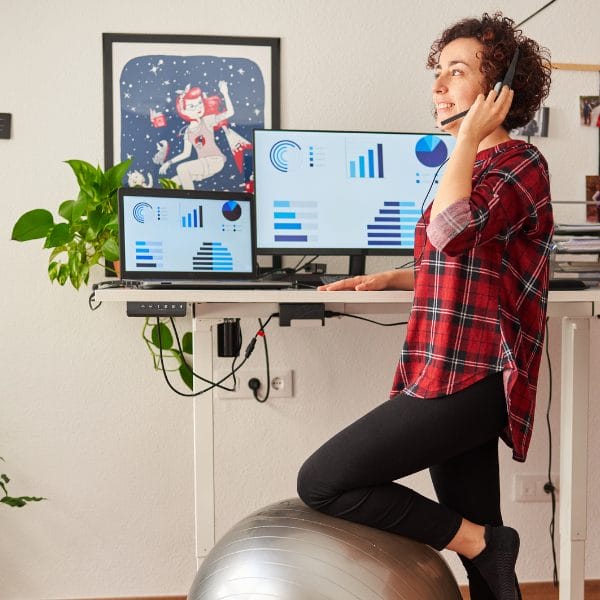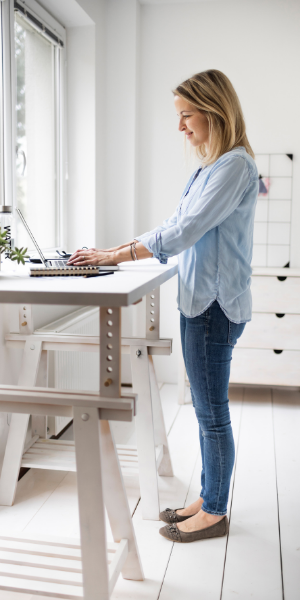What to Look for in Your Standing Desk: A Comprehensive Guide
Standing desks have been proven to have many benefits. They increase productivity, decrease fatigue, and decrease back pain.
PostureGeek.com Tweet
Standing desks have been proven to have many benefits. They increase productivity, decrease fatigue, and decrease back pain. Sounds great, right? But how do you know if a standing desk is suitable for you?
This article will give you some tips on what to look for in a standing desk, as well as recommendations for what might work best for you. In addition, we’ll go over how to make the transition from sitting to standing with as little pain as possible.

What is a standing desk?
A standing desk is a work surface that can be raised to standing height or lowered for sitting. This allows the user the option of standing up periodically throughout the day instead of remaining seated. Standing desks can be raised and lowered by either an electric motor or by using a crank mechanism.
Benefits of a standing desk

The benefits of a standing desk are plentiful.
Increased Productivity: Some studies have shown standing at your desk can increase productivity by up to 15%. Standing allows you to burn more calories and work longer without getting tired, so the time you spend working is both more productive and enjoyable.
Decreased back pain: Sitting for extended periods has been linked to poor posture, back pain, and even reduced mobility as you age. Standing desks allow you to keep your back straight so your spine is in proper alignment.
Decreased fatigue: Again, standing allows you to burn more calories without tiring out too quickly. This means standing desks reduce fatigue by increasing productivity, enabling you to take more breaks throughout the day.
Decreased risk of diabetes: Sitting for extended periods has been linked to an increased risk of obesity and diabetes. However, standing helps increase blood flow, so standing desks decrease your risk of developing these diseases.
Better brain function: Studies have shown standing improves memory functions and overall brain function. This makes standing at work perfect for jobs that require focus and creativity.
Essentially, it’s an entirely different way of doing things, and while it can be uncomfortable initially, you’ll soon get used to the change and become much more productive.
Don’t forget to consider you your standing posture!
How to choose a standing desk
Standing desks are height-adjustable, which means that you can find one for any height. This also means that you're able to lower it to a sitting position if standing becomes too uncomfortable.
PostureGeek.com Tweet

If your answer is that you want to avoid sitting and still get your work done, you need an ergonomic standing desk.
An ergonomic standing desk is a standing desk that provides you with all the features that can make standing at work painless.
More importantly, standing desks are height-adjustable, which means that you can find one for any height. This also means that you’re able to lower it to a sitting position if standing becomes too uncomfortable.
What to look for in standing desks

Height: The standing desk must be tall enough so you can get off your seat and move around without feeling any discomfort or strain in your legs.
Space: You should consider the shape, size, and location of your current workspace. For example, standing desks with mobile surfaces are best suited to cubicle spaces because they take up less room than standing desks with bulky standing frames. You should also consider the standing desk height, so you can get in and out of your seat without difficulty.
This means standing desks come in three options:
- Stationary standing desks – these are fixed standing desks that cannot be lowered.
- Height adjustable standing desks can be raised or lowered to sit or stand by using a crank mechanism.
- Fully adjustable standing desks – these options allow you to easily move between sitting and standing positions without having to lift.
You should also look for these features when researching an ergonomic standing desk:
- Look for casters, so it’s easy to move around
- A suitable standing desk has plenty of electric ports, so you have an available power source
- Anti-fatigue mats are a good idea because they provide comfort and support – An ergonomic standing desk should also have a cable management system so you can keep wires organized
Make the transition from sitting to standing with as little pain as possible.
Transitioning from a seated position to standing might seem daunting, but there are some steps you can take to make the transition more comfortable.
Start standing for short periods: Standing is a new activity, and standing for extended periods will feel uncomfortable at first. Instead, stand up and work in sets so you can take breaks and walk around in between.
Use standing desks during conference calls: Standing desks can make participating in those conference calls more comfortable if you are on many conference calls throughout your workday. Most standing desks come with a built-in shelf specifically designed to hold phones and tablets for participants to use during phone conference calls.
How do you make the switch to standing?

The first step to switching from sitting to standing is to make sure you have the right equipment. The best way to find out is to find a qualified professional to come and assess your work or home office setup.
A professional can give you guidelines and recommendations for optimal positioning and use. The following are a few essential considerations to make sure you get the best standing desk out there.
Positioning: The basic rule of thumb is that you should be comfortable standing for no more than 3 hours. This may seem like a lot, but it really depends on your body. You need to make sure that your back doesn’t start to ache, your legs feel cramped, or your muscles become fatigued.
Adjustability: Your standing desk needs to be easily adjustable so you can move between standing and sitting as needed.
Size: The best standing desks are those that fit your body perfectly. This means standing with as little weight as possible on your feet for as long as possible.
Material: Material is an important consideration, especially if you’re standing for longer than 15 minutes at a time. The best standing desks use materials like steel and aluminum, which resist corrosion and rusting.
Cost: Lastly, we’ll take a look at the most crucial consideration: price. Of course, you want to get the highest quality standing desk out there, but you also want to make sure you don’t break the bank.
So, before you make a purchase, consider what works best for your body and try standing in between sitting to cover the entire range of standing positions.
What to do when standing at work hurts. Some tips for making it easier on yourself.

Do not assume that you are supposed to be standing all the time at your workstation. This can have an inverse effect on what you are trying to achieve with moving to a workstation.
Here are some useful tips for standing at your desk without pain:
1. Find the right standing desk height!
Depending on your standing desk’s height, standing while working can be either easy or difficult. It’s best to go with a standing desk that allows you to set the desired height. If you aren’t able to do this, it may be worth getting some risers so you can get the right standing desk height.
2. Invest in anti-fatigue standing desk mat.
Standing desk mats provide comfort and support, which means you’re standing for longer without any pain. Anti-fatigue standing desk mats can absorb shock and reduce stress on your body, as well as give your legs a break from standing all day long. This will prevent discomfort and pain in the lower limbs, making standing at your standing desk more comfortable.
3. Take a standing break.
Be sure to take standing breaks for the sake of both your body and mind during the day! It’s good to simply sit down for a few minutes, even if it’s just once an hour or so. Just stand up, walk around for a few minutes, and then get back to standing. You’ll feel better for standing up too frequently as opposed to standing all day long without taking breaks!
4. Don’t stand still.
While it may be tempting, don’t stand in the same position all day long like a statue! This will only make standing at your standing desk that much more difficult.
Conclusion
Before purchasing a standing desk, take the time to measure your workspace and determine what features you need in a standing desk.
PostureGeek.com Tweet

Standing desks come in many different shapes and sizes, but standing desk accessories can make standing more comfortable during work. Standing for short periods won’t feel natural at first, so standing desk accessories can help you transition to standing.
Before purchasing a standing desk, take the time to measure your workspace and determine what features you need in a standing desk. Then you can find the standing desk that best fits your workspace and needs. Finally, when standing at work is comfortable, you can start standing for days in a row to see how standing affects your productivity and health.
Thank you for reading PostureGeek.com! We hope this article helped you decide if standing desks are suitable for you and how to make the transition from sitting to standing easier.
If standing desks aren’t for you, make sure to read posturegeek.com’s HOW TO SIT AT YOUR DESK: STEPS FOR A HEALTHY WORKSTATION.
PLEASE NOTE
PostureGeek.com does not provide medical advice. This information is for educational purposes only and is not intended to be a substitute for professional medical attention. The information provided should not replace the advice and expertise of an accredited health care provider. Any inquiry into your care and any potential impact on your health and wellbeing should be directed to your health care provider. All information is for educational purposes only and is not intended to be a substitute for professional medical care or treatment.
